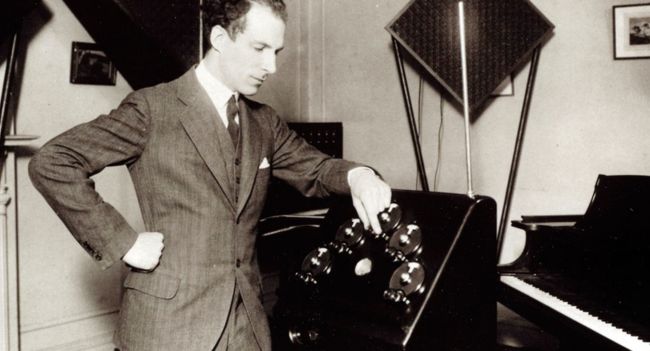You know the sound of the theremin, that weird, warbly whine that signals mystery, danger, and otherworldly portent in many classic sci-fi films. It has the distinction of being not only the very first electronic instrument but also the only instrument in history one plays without ever touching any part of it. Instead, the theremin player makes hand motions, like the conductor of an invisible choir, and the device sings. You can see this yourself above, as the instrument’s inventor, Léon Theremin, demonstrates his thereminvox, as he called it at the time, in 1954. Speaking in Russian, with English subtitles, Theremin describes how the “instrument of a singing-voice kind” works “by means of influencing an electromagnetic field.”
Theremin originally invented the instrument in 1919 and called it the Aetherphone. He demonstrated it for Vladimir Lenin in 1922, and its futuristic sound and design made quite an impression on the ailing communist leader. Theremin then brought the device to Europe (see a silent newsreel demonstration here) and to the U.S. in 1927, where he debuted it at the Plaza Hotel and where classical violinist Clara Rockmore, soon to become the most devoted proponent and player of the theremin, first heard it.
Although many people thought of Theremin’s invention as a novelty, Rockmore determined that it would be taken seriously. She apprenticed herself to Theremin, mastered the instrument, and adapted and recorded many a classical composition, like Tchaikovsky’s “Berceuse,” above. More than anyone else, Rockmore made the theremin sing as its inventor intended.
The origin story of the theremin, like so many invention stories, involves a happy accident in the laboratory. Just above, Albert Glinsky, author of the history Theremin: Ether Music and Espionage, describes how Theremin inadvertently created his new instrument while devising an audible technique for measuring the density of gases in a chemistry lab. The first iteration of the instrument had a foot pedal, but Theremin wisely decided, Glinsky says, that “it would be so much more intriguing to have the hands purely in the air,” manipulating the sound from seemingly nowhere. Although there are no frets or strings or keys, no bow, slide, or other physical means of changing the theremin’s pitch, its operation nonetheless requires training and precision just like any other musical instrument. If you’re interested in learning the basics, check out the tutorial below with thereminist Lydia Kavina, playing a ‘thereamini’ designed by synthesizer pioneer Moog.
In his day, Theremin lived on the cutting edge of scientific and musical innovation, and he hoped to see his instrument integrated into the world of dance. While working with the American Negro Ballet Company in the 1930s, the inventor fell in love with and married a young African-American dancer named Lavinia Williams. He was subsequently ostracized from his social circle, then he either abruptly picked up and left the U.S. for the Soviet Union in 1938 or, more likely, as Lavinia alleged, he was kidnapped from his studio and whisked away. Whatever the case, Theremin ended up in a Gulag laboratory called a sharaska, designing listening devices for the Soviet Union. Thereafter, he worked for the KGB, then became a professor of physics at Moscow State University.
Theremin never gave up on his electronic instruments, inventing an electronic cello and variations on his theremin during a 10-year stint at the Moscow Conservatory of Music. He gave his final theramin demonstration in the year of his death, 1993, at age 97. (See him playing above in 1987 with his third wife Natalia.) To learn much more about the inventor’s fascinating life story, be sure to see Steven M. Martin’s 1993 documentary Theremin: An Electronic Odyssey.
And if you’re intrigued enough, you can buy your very own Theremin made by Moog.
*Note: an earlier version of this post stated that a theremin was used in the Beach Boys’ “Good Vibrations” and the original Dr. Who theme. While a common misconception in both cases, it appears that neither piece of music contains the instrument but rather both used other instruments and techniques to obtain a similar sound.
